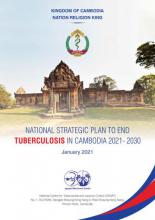The National Strategic Plan (NSP) to End TB 2021-2030 sets out the directions and key initiatives that the National Centre for Tuberculosis and Leprosy Control (CENAT) Ministry of Health and partners will undertake during the plan period to work towards achieving the goal of ending TB by 2035 in Cambodia. We have seen tremendous commitment and the progress achieved over the last NSP period 2014-2020, yet much more needs to be done to accelerate the nation’s progress towards a TB free Cambodia.
Cambodia achieved Millennium Development Goals (MDGs) four years before the target date. More than 500,000 TB patients were treated and cured, and 400,0002 deaths have been averted since 2000. WHO’s estimated TB incidence in Cambodia has declined from 575 in 2000 to 423 in 2011, and 302 per 100,000 population in 2018. The country achieved an impressive 38% decline in prevalence of smear positive TB over a 9-year period (2002-2011) - an average of 4.2 % per year. However, the rate of decline has been slower since 2015, and innovative solutions are required to address this epidemic.
The treatment success rates remain high, 94% for drug-sensitive TB (2016 cohort) amongst the best in the world, and 71% for Multidrug-Resistant Tuberculosis (MDR-TB) (2015 cohort). TB/HIV co-infection and drug-resistant
TB do not contribute much to the burden in Cambodia. TB services are available in all public health facilities. There is hard evidence of progress through two consecutive national prevalence surveys 2002 and 2011 that TB prevalence in Cambodia is declining. Hence, the foundations to meet the Sustainable Develop Goals (SDG) TB targets through actions expected in Moscow Declaration and United Nations High Level Meeting (on TB) (UNHLM) are in place.
However, Cambodia remains one of the 30 high burden countries. More than one-third of TB patients are undetected or unreported and still infectious because they have no symptoms or have poor access to health care facilities. An estimated 49,000 people fell ill with TB in 2018, and an estimated 3,500 people died due to TB. TB contribute to the losses to the national economy. Under-nutrition, smoking, alcohol, diabetes and HIV contribute to driving the TB epidemic.
There are major constraints limiting progress including the current levels of finances that are insufficient; TB response is largely limited to the health sector; Limited access to X-ray and WHO recommended rapid diagnostics such Xpert machine; Active case finding (ACF) is not yet scaled up to the entire country; Private providers are not engaged and hospital involvement is incomplete; TB notification is not mandatory; Engagement of partners is confined to time-bound and resource-limited projects; there is limited geographic coverage of some innovative and successful initiatives; and about a third of TB patients and their affected families may face catastrophic costs due to medical and non-medical expenses and income loss related to TB.






